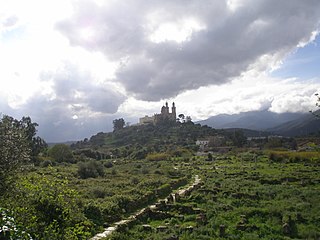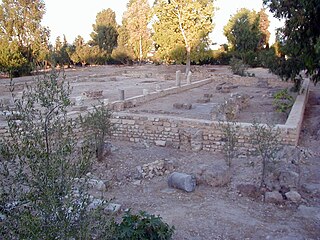Related Research Articles

Hippo Regius is the ancient name of the modern city of Annaba, Algeria. It historically served as an important city for the Phoenicians, Berbers, Romans, and Vandals. Hippo was the capital city of the Vandal Kingdom from 435 to 439 AD. until it was shifted to Carthage following the Vandal capture of Carthage (439).

The Archdiocese of Tunis is a Latin Church ecclesiastical territory or diocese of the Catholic Church in Tunis, Tunisia. It was founded on 10 November 1884 under the name "Archdiocese of Carthage", with territory corresponding to that of the then French protectorate of Tunisia. On 9 July 1964, it became a territorial prelature under the ecclesiastical title of Prelature of Tunis. It was made a diocese, keeping the name of Tunis, on 31 May 1995, and raised to the rank of archdiocese on 22 May 2010.

The name early African church is given to the Christian communities inhabiting the region known politically as Roman Africa, and comprised geographically somewhat around the area of the Roman Diocese of Africa, namely: the Mediterranean littoral between Cyrenaica on the east and the river Ampsaga on the west; that part of it that faces the Atlantic Ocean being called Mauretania, in addition to Byzacena. Thus corresponding somewhat to contemporary Morocco, Algeria, Tunisia and Libya. The evangelization of Africa followed much the same lines as those traced by Roman civilization. From the late fifth and early sixth century, the region included several Christian Berber kingdoms.

Thelepte was a city in the Roman province of Byzacena, now in western Tunisia. It is located near the border with Algeria about 5 km north from the modern town of Fériana and 30 km south-west of the provincial capital Kasserine.

Haïdra is a municipality in western Tunisia, containing the ruins of Ammaedara, one of the oldest Roman cities in Africa. It was a diocese and is now a Roman Catholic titular see.

Assuras, sometimes given as Assura or Assur, was a town in the Roman province of Proconsular Africa.

Abitinae was a town in the Roman province of Africa Proconsularis and is famed for the Martyrs of Abitinae.
Casae Calanae was a town in the Roman province of Numidia.
The Primate of Africa is an honorific title in the Roman Catholic church, but in early Christianity was the leading bishop (primas) in Africa except for Mauretania which was under the bishop of Rome and Egypt which was suffragan to Alexandria.
Thagora was a Carthaginian and Roman town at what is now Taoura, Algeria.

Zama, also known as Xama, is in what is now Tunisia and is best known for its connection with what is called the Battle of Zama in which on 19 October 202 BC, Scipio Africanus defeated Hannibal, which ended the Second Punic War with victory for the Roman Republic and broke the power of Ancient Carthage.

Thibaris was a town in the late Roman province of Africa Proconsularis.
Rucuma is a former city and bishopric in Roman North Africa, which remains a Latin Catholic titular see.

Bonusta was a town, not far from Carthage, in the Roman province of Africa Proconsularis. No trace of it has been identified.

Avitta Bibba was a town in the Roman province of Africa Proconsularis. The town is tentatively identified with ruins at Henchir-Bour-Aouitta in Tunisia.

The Archdiocese of Carthage, also known as the Church of Carthage, was a Latin Catholic diocese established in Carthage, Roman Empire, in the 2nd century. Agrippin was the first named bishop, around 230 AD. The temporal importance of the city of Carthage in the Roman Empire had previously been restored by Julius Caesar and Augustus. When Christianity became firmly established around the Roman province of Africa Proconsulare, Carthage became its natural ecclesiastical seat. Carthage subsequently exercised informal primacy as an archdiocese, being the most important center of Christianity in the whole of Roman Africa, corresponding to most of today's Mediterranean coast and inland of Northern Africa. As such, it enjoyed honorary title of patriarch as well as primate of Africa: Pope Leo I confirmed the primacy of the bishop of Carthage in 446: "Indeed, after the Roman Bishop, the leading Bishop and metropolitan for all Africa is the Bishop of Carthage."
Musti in Numidia, also called Musti Numidiae, was an ancient city and bishop jurisdiction (bishopric), and is presently a Catholic titular see,(bishop's government see of a former government under a church's responsibility, also known as a dead diocese.) in modern Algeria.
Tigisis, also known as Tigisis in Mauretania to distinguish it from another Tigisis in Numidia, was an ancient Berber town in the province of Mauretania Caesariensis. It was mentioned in the Antonine Itinerary.

Libertina was a town of the Roman province of Byzacena in North Africa during the Roman Empire. The town is tentatively identified with ruins near Souc-El-Arba, Tunisia.
Bisica was a civitas of Roman North Africa, tentatively identified with ruins at Bijga in today's Tunisia.
References
- ↑ Stefano Antonio Morcelli, Africa christiana, Volume I, Brescia 1816, pp. 292–293
- ↑ Annuario Pontificio 2013 (Libreria Editrice Vaticana, 2013, ISBN 978-88-209-9070-1), p. 979
- Attribution
 This article incorporates text from a publication now in the public domain : Herbermann, Charles, ed. (1913). "Tabbora". Catholic Encyclopedia . New York: Robert Appleton Company.
This article incorporates text from a publication now in the public domain : Herbermann, Charles, ed. (1913). "Tabbora". Catholic Encyclopedia . New York: Robert Appleton Company.